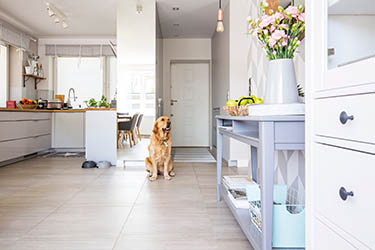Dog Proofing Tips for Clients

The importance of dog-proofing
Dogs love to explore, especially with their mouths. Without training, dogs are adamant table sharks, searching for snacks and eating everything they find. The best time to dog-proof a house is before bringing home the new family member. However, you can offer clients with new puppies a few tips to keep their homes and their dogs safe.
The kitchen tends to be the room in the house with the most dangers. Kitchens have countertops and cabinets perfect for exploration. The smell of food cooking is as enticing for dogs as it is for humans. Here are a few items and areas of the kitchen that you can remind your clients to dog-proof:
- Lower cabinets might have cleaners and detergents that can lead to poisoning.
- Accessible garbage cans might smell enticing to a dog, particularly if leftover food has been discarded. Splintering bones can lead to poisoning, sickness or gastrointestinal injury.
- Plastic wraps can be choking hazard and should be stored out of reach in hard to access locations.
- Food and beverages should never be left on the counter or in an area that is easily accessible to a dog. It is important to be particularly mindful of foods that can cause toxicity in dogs. For example, chocolate, onions, grapes, raisins, macadamia nuts and alcohol are all dangerous for a dog to ingest.
Other places to proof
Before your client is able to properly train his or her new puppy, proofing the entire house is necessary. The first step is to go over the obvious points in a home that could be a danger. Examples are similar to those addressed when baby-proofing and include:
- Hiding and taping electrical wires
- Gating off stairways, decks or balconies
- Securing all doors
- Properly screening fireplaces
- Securing precariously placed items likes vases and statutes
- Putting away choking hazards like children’s toys
- Keeping closets closed (this protects the owner’s things as well as the puppy)
The American Humane Society offers a more comprehensive list of areas of the home to proof for curious cats and dogs. Here is a list compiled by room/area of the home that you can provide for your clients:
Kitchen/Bathrooms
- Secure cabinets with childproof latches
- Keep trashcans latched or covered.
- Keep food out of reach
- Keep medications, chemicals, and cleaning supplies on a high shelf
- Keep the toilet lid closed to prevent the drinking of cleaning chemicals
Family Room
- If possible, place wires from lamps and other electronics out of reach
- Keep the floor tidy of children’s toys
- Move common house plants that could be poisonous to areas out of reach
- Cover all heating/air vents
Garage
- Keep chemicals (cleaning and auto) on high shelves
- Clean any spills, such as antifreeze and oil, from the floor and driveway
- Keep all sharp objects and tools out of reach
Bedrooms
- Keep all laundry and shoes between closet doors
- Move electrical wires out of reach.
- Keep lotions, medications and cosmetics off of accessible surfaces
Click here for a printable fact sheet on pet-proofing from the American Humane Society.
Contact your Covetrus representative for more information at 8855.724.3461 or online.
Sources:
http://www.vetstreet.com/our-pet-experts/a-handy-guide-to-dog-proofing-your-home
https://www.americanhumane.org/fact-sheet/pet-proofing-your-home/
Careers
Are you looking for a place to let your talents shine? At Covetrus, we help our practitioner customers better serve their patients and take pride in providing the best customer experience possible. Search our open positions to see our available opportunities.
Newsletter
Stay current with what’s going on with Covetrus, subscribe to receive our newsletter and email communications. Subscribers will receive the latest information in practice management, sales and marketing, animal health, and more.


Leave a comment